
On the eve of the launch of the DevOps Practices and Tools course , we held another open lesson . The webinar turned out to be very informative. In fact, it was an hour and a half non-stop practice :
- considered 4 basic tools of a modern DevOps engineer, each of which implements basic practices: infrastructure as code, CI / CD, feedback;
- learned not to break history in Git and work well in a team;
- They discussed how Ansible differs from other systems, and why we study it on the course;
- looked at Docker and explained why containers and microservices are more likely to defeat monolithic architectures.
Workspace:
- Ubuntu 18.04;
- Python 3
- All necessary software was installed during the webinar.
Lecturer - Lev Nikolaev , DevOps-engineer and trainer in the company "Express 42". The lesson was held in the "Demo" mode.
Demo 1
Let's start by launching the virtual machine, because we will do all the work there. And right away we’ll make a directory called “Hello”, where we will develop our application:
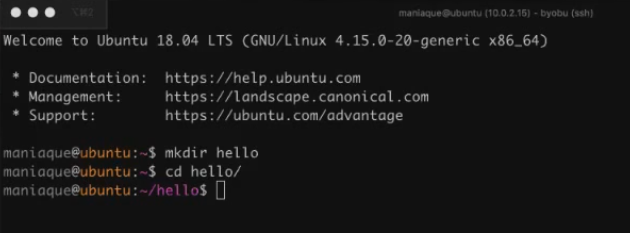
Then create a file called app.py , where we paste the following code:
#!/usr/bin/env python3 import datetime def do_magic(): now = datetime.datetime.now() return "Hello! {0}".format(now) if __name__ == "__main__": print(do_magic())
As you can see, there is nothing complicated in the code. But if we include the file as a module from another application, it will not do anything, but will only do it if we run it directly as an application, for which the following construction is responsible:

And, accordingly, a very simple thing happens in the
do_magic()
function itself: we get the time now in the
now
variable and display it on the screen with the text
«Hello!»
.
Stylish, fashionable, youthful, simple - this is the so-called Stateless-application, which basically does not need anything to work, for example, a database. At the same time, our application, consisting of 10 magic lines of code, is ready to receive a service upon receipt of a request.
The next important feature is that we want our application to work via the web . But let's imagine that our code is very complicated, and we want to be able to check it somehow before posting. To do this, we mark the app.py file as executable and immediately check in the console that everything works:

We also need a tool that will allow us to control the development of the application, for example, changes in versions, etc. The well-known Git version control system, which is installed by a simple command, will come in handy here:
sudo apt install git
Of course, you will need to create a Git repository in our directory, which we do, and then run
ls -la
:

Having completed the
git status
command, we will see that there are no commits yet, and the file that contains our code is completely foreign to the git, because it is in the
Untracked
category:

Of course, this should be corrected, but before that we will do another important thing - explain the gita who we are. Why is it important? The fact is that when you save some version of the code, you must write who made the commit, what is his name, and what is his email address. Without these settings, the git simply will not let us commit.
Two simple commands will help us:

Now add our file, saying that this is the first version of the application. And after a successful commit, we’ll immediately see the history with the git log command:

If we want to see a more detailed history of changes, add the
–p
parameter to the git log command:
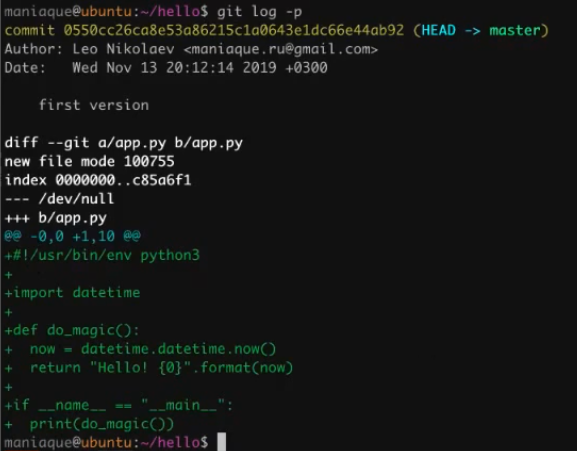
As we see, now diff will be attached to each commit of the changes that occurred, that is, we will see which lines are added and which are removed. This is very convenient if you work with code.
Demo 2
Now imagine that they require us to open and work in a browser . This can be done by the mega-ancient method.
First, install Apache:
sudo apt install apache2
After checking the browser, we see that Apache is installed:
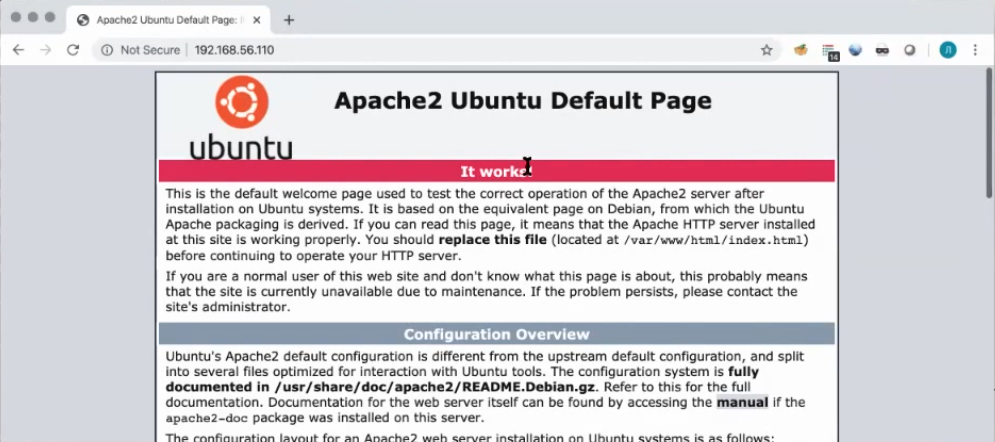
Apache expects it to dump the files it will have into a specific directory. It can be seen, but there is nothing there yet:

Let's now go to the
/var/www/html
directory and do a very simple thing: move the old html directory to html2. And then we’ll do another tricky thing: we’ll direct the html directory to the home directory where we have the application:
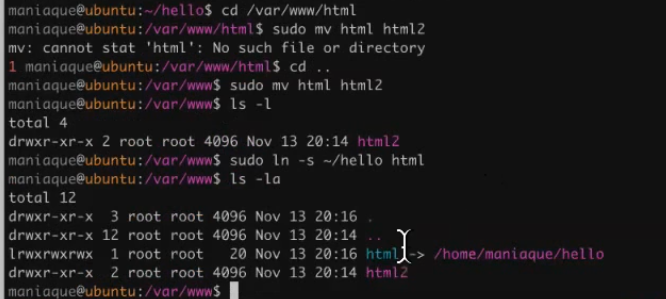
What happened in the end? We created a shortcut, but this shortcut is html and, as they say, the squad will not notice the loss of a fighter. Now, when we access the web server, Apache will run into our directory, where the application lies. But just like that, he won’t launch the application.
So, you need to continue to configure. First, enable the Apache module responsible for running external scripts:

But we won’t start yet, because we still need to add the ability to override Apache settings by creating files in our project directory. To do this, let's fix the default Apache site:

And we add a very simple construction here: let's say that in the
/var/www/html
directory you can redefine anything you like by adding just 3 lines of code:

Now you can restart Apache, go to your project directory and make a special
.htaccess
file that will allow you to override settings on the fly:

Here are the settings:

Deciphering the lines:
- If you see a file with the extension
.py
, then this is acgi-script
, and it must be executed. - We allow the execution of scripts in the desired directory.
- Unless stated otherwise, you need to select the
app.py
file as the index.
As you can see, the settings are simple. But if we try to update the browser, we will see Internal Server Error. In fact, the reason is that our script displays the time and the message “Hello!”, But this is not quite what Apache expects from it. The problem is solved by adding one simple line to the code:
#!/usr/bin/env python3 import datetime def do_magic(): now = datetime.datetime.now() return "Hello! {0}".format(now) if __name__ == "__main__": print("Content-type: text/html\n\n") print(do_magic())
With this line (
print("Content-type: text/html\n\n")
) we say that before displaying the magic, we need to write
Content-type: text/html\n\n
so that Apache understands better.
Voila! We went from a simple regular application to a simple web application in about 20 minutes:

Now we fix this version, adding only
app.py
to the commit:

After looking at the log, we will see that we already have two versions, and the second version is modified for CGI execution.
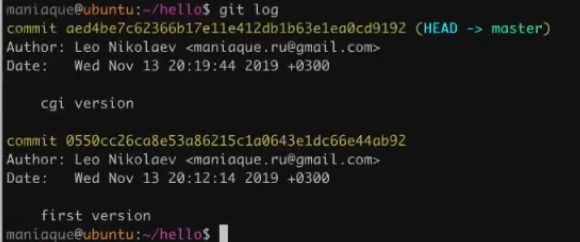
Everything is great, but I want versatility. So that when we launch the application with the
./app.py
command, the text
Content-type: text/html
does not
./app.py
out:

To do this, edit our code, modifying it:
#!/usr/bin/env python3 import datetime import os def do_magic(): now = datetime.datetime.now() return "Hello! {0}".format(now) if __name__ == "__main__": if 'REQUEST_URI' in os.environ: print("Content-type: text/html\n\n") print(do_magic())
Now, if the call is made through Apache, the
print("Content-type: text/html\n\n")
line
print("Content-type: text/html\n\n")
added, and if the call is made just like that, it is removed (not shown).
Next, check the status and add the
.htaccess
file to the project, since it is part of our code. And we commit:

Everything turned out very well, so it's time to mark what happened as a certain version by adding a tag :
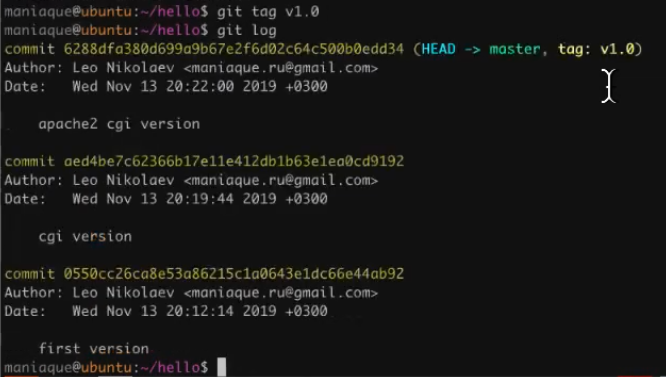
What does the tag give? For example, the ability to return (roll back) to the desired version of the code.
A brief conclusion from this demo:
- GIT helps us navigate code versions and understand what is going on;
- we can mark some commits especially (tags).
In fact, everything is just beginning ... First, they will tell you that CGI is not cool, because you create your own separate process for each request. Secondly, for Python it is stylish, fashionable and youthful to use WSGI (whiskey). Thirdly, as a software implementation we can use uWSGI. So, we move on.
Demo 3
So, we want to continue to work with the code and make changes to it, but we don’t want our colleagues to see this, or to somehow interfere with them. Therefore, we use a feature of a geet called branch . It allows you to create a branch (a copy of the repository with all its code), where we will further add our commits. And when we consider that the development is completed, it will be possible to pour changes into the main repository.
To create a copy of the repository, execute a simple command:

For compatibility with the uWSGI standard, make changes to the code:
#!/usr/bin/env python3 import datetime import os def do_magic(): now = datetime.datetime.now() return "Hello! {0}".format(now) def application(env, start_response): start_response('200 OK', [('Content-Type','text/html')]) return [do_magic().encode()] if __name__ == "__main__": if 'REQUEST_URI' in os.environ: print("Content-type: text/html\n\n") print(do_magic())

Now you need to install what is needed for this version to work, because uWSGI is a special server:
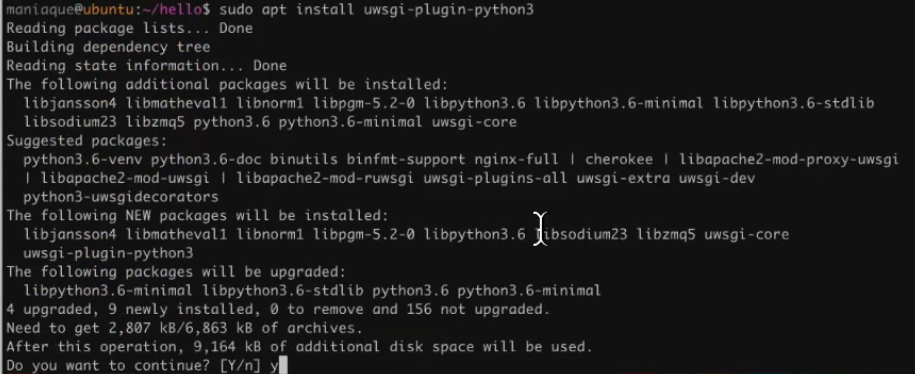
To run our file, we perform the following remarkable construction:

In it we ask:
- start the uWSGI daemon;
- load the plugin for Python 3;
- start the web server on the port: 9090;
- use the app.py file as the starting file.
Hooray, everything works:

Further, we understand that it is rather tedious for us to remember the settings with which we need to start the uWSGI server. Therefore, we will use the ability of uWSGI to drag data from a file. Create the
dev.ini
file, putting all the necessary parameters into it:
[uwsgi] plugin=python3 http-socket=:9090 wsgi-file=app.py
And now everything starts with a simple
uwsgi dev.ini
.
app.py
looked at the status of the working directory, we add the
app.py
and
dev.ini
, commit, then we can perform the merge , pulling our changes to the main branch.

We will see that our changes are perfectly integrated on top of what happened.
What did we see in this demo:
- git allows us to branch - to create full copies for editing;
- and then they can be injected into the main branch master;
- while we are editing in a branch, we are not bothering anyone.
While we work exclusively locally, however this does not mean that others cannot make commits right there.
Demo 4
So, we now use the built-in uWSGI server, but this is not very cool, because it is not very productive. In general, it would be nice to use nginx, because it is fashionable. In addition, the boss is in negotiations, so in the near future the project will have to be rolled out, and the air smells like a quick deploy.
Let's start by turning off Apache2 and installing
nginx
.

Now let's create a simple configuration file that will allow nginx to accept incoming connections and forward them to uWSGI, that is, we will get a more or less modern web stack. But first, delete the default nginx configuration files, i.e., we need to put ours there. We also create the configuration file of our server and restart
nginx
:

Here are the contents of our configuration file:
server { listen 80; root /var/www/html; location / { include /etc/nginx/uwsgi_params; uwsgi_pass 127.0.0.1:9000; uwsgi_param Host $host; uwsgi_param X-Real-IP $remote_addr; uwsgi_param X-Forwarded-For $proxy_add_x_forwarded_for; uwsgi_param X-Forwarded-Proto $http_x_forwarded_proto; } }
In fact, the configuration is very simple: we ask the server to listen on port 80, use
/var/www/html
as the root directory, and forward traffic to the address
127.0.0.1:9000
when the root directory is accessed. And not just forward, but do it in the
uwsgi
format, where the
uwsgi
daemon will wait for it and give it the result of its work, as a result of which users will be able to see our wonderful application. And this is exactly the way we will work with
production
with
nginx
and
uwsgi
.
Now you can go to our directory and copy the settings created at the development stage to the sales settings.

And we edit the settings, changing one line:
[uwsgi] plugin=python3 socket=127.0.0.1:9000 wsgi-file=app.py
That is, instead of an HTTP server, we ask you to open a socket ready for communication via the
uwsgi
protocol, where
nginx
can go.
Next, go to our directory and run
uwsgi
with the sales settings:

After that, we make sure that everything works and is ready for deployment:

What are the results of Demo 4 :
- we gradually began to prepare for the product;
- usually a technology stack consists of many components, where everyone does their job;
-
nginx
handles many requests and does it well; -
uWSGI
can behave as it should in the right amount of resources; - we got the first artifact - the
nginx
config (in fact, not the first, but the first, which is not ours).
Demo 5
As soon as we finished the next cup of coffee, the chef came running and said that it was time to do a deploy. This means that we have to write not just code, but infrastructure code, that is, the code that our application can roll out.
It’s not with your own hands to do this, because the client has 5 thousand servers, and they are located in different data centers and scattered around the world, and we need to deploy our application there. And we understand that we need to somehow move to the storage of infrastructure code. In this case, we make an engineering decision to store the infrastructure code in the same directory as our application code. This, by the way, is one of the devops practices . When we are talking about deployment, we mean that deployment should be automated, automation means writing infrastructure code, and we can store infrastructure code both with the application and separately. Since the application is simple, we decide to store everything together.
What do we do next? We go to our directory and create 5 directories in one motion, and they are different:

Why do we need this? The fact is that our code can be launched using Apache, using nginx, uWSGI, and systemd will be needed, so you need to put it all together beautifully and efficiently. What we do:

As you can see, the repository has become beautiful: the
app.py
application
app.py
remained in place, everything else has gone to the
deploy
directory. Now we can add the deploy directory to the tracking and commit immediately with all the changed files, saying that we are ready for the deployment:

Well, it's time to share the code with the outside world. So, we need to prepare the opportunity to lay out this code somewhere. In our case, you can use your account on the github by creating a public repository named “Hello”. To work with github, we perform the necessary settings. Since everything is configured using SSH keys, you do not need to enter any logins and passwords.
Throw changes to github:
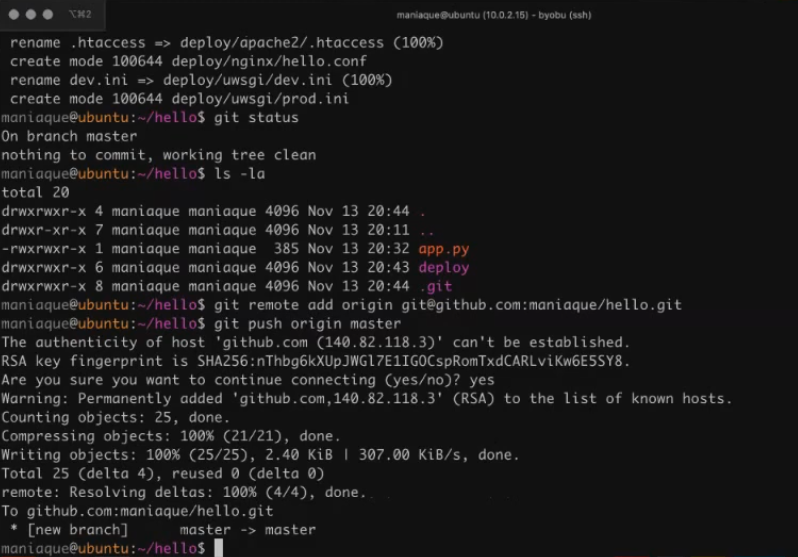
Everything seems to be cool, only tags in our remote repository will not be enough. Why, because we did them? The fact is that tags are not automatically transferred to the remote repository, so we will pass the tag manually:

Now our version will appear in the releases section and will be a certain version of the application that can be downloaded in the archive:

We have one more task: to make our uWSGI daemon start automatically, while we don’t want to use any external tools. To solve this problem, create a unit file for
systemd
:

With the following contents:
[Unit] Description=Hello app Requires=network.target After=network.target [Service] TimeoutStartSec=0 RestartSec=10 Restart=always WorkingDirectory=/opt/hello KillSignal=SIGQUIT Type=notify NotifyAccess=all ExecStart=/usr/bin/uwsgi deploy/uwsgi/prod.ini [Install] WantedBy=multi-user.target
As you can see, the code is quite simple, but there are interesting points
.
We save the file and ask
systemd
reread the changes from the disk so that it sees a new service. But before you do this, you need to go to the
opt
directory, become the superuser and say that we want to clone the repository:

Now we can safely start, and the console will not swear:

After checking, we will make sure that everything works beautifully,
systemd
takes
systemd
everything, and everything is fine.
In principle, we built some kind of configuration that we would like to see in the deployment. Now we return to the home directory, copy our script and put it in the
deploy
folder:

And now, in principle, we are ready to deploy to any server. So, you can commit and create a new release 2.0:
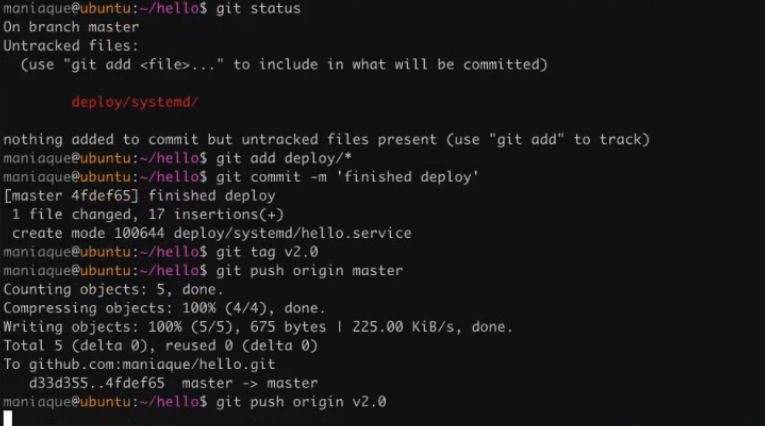
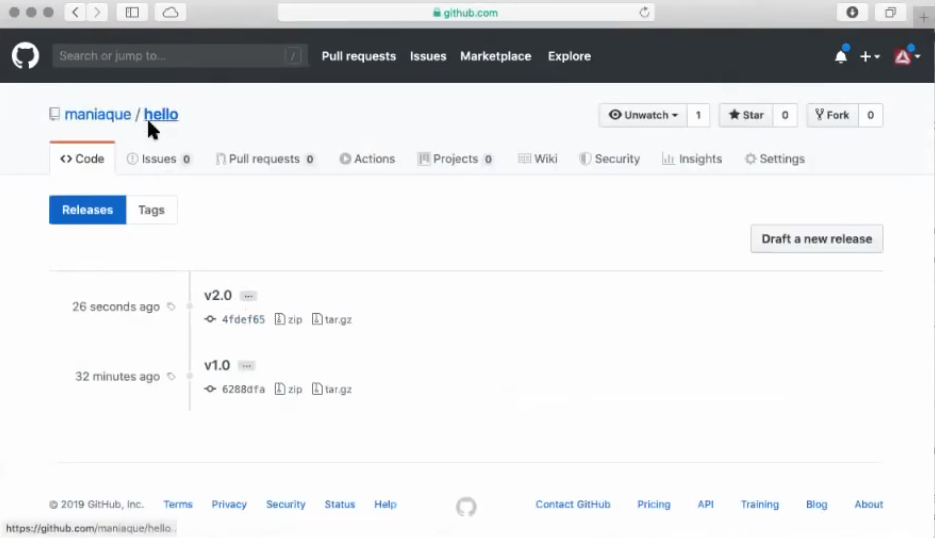
Well, let's stop our text translation on this. However, you can continue to browse, as the day of the devs engineer has not yet ended and there is still ahead:
- Demo 6 - use Ansible to automate deployment;
- Demo 7 and Demo 8 - practice Docker and simplify container launch using docker-compose;
- Demo 9 - welcome to Kubernetes!
And keep a link to the github project.